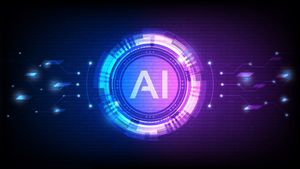
San Francisco, CA – September 29, 2025 – The cryptocurrency research landscape has undergone a profound transformation by September 2025, largely driven by the pervasive integration of advanced Artificial Intelligence (AI) tools, most notably ChatGPT. These sophisticated AI models are no longer mere辅助工具 but indispensable engines for discerning market sentiment, deciphering complex on-chain data, and unearthing elusive "hidden gems" within the highly volatile digital asset markets. The immediate implications are clear: unprecedented efficiency and speed in analysis, democratized access to high-level insights, and a significant bolstering of security measures within the crypto ecosystem. However, this rapid evolution also brings forth critical discussions around market volatility, potential manipulation, and the urgent need for ethical and regulatory frameworks.
The symbiotic relationship between blockchain's immutable data and AI's analytical prowess has culminated in a new era of data-driven crypto investing. From sifting through mountains of social media chatter to tracking the intricate dance of "smart money" on various blockchains, AI is augmenting human capabilities, enabling investors and analysts to make faster, more informed decisions in a market that never sleeps. While AI's role is primarily seen as an augmentation rather than a replacement for human judgment, its growing sophistication is fundamentally reshaping how opportunities are identified and risks are managed in the dynamic world of cryptocurrencies.
The Algorithmic Eye: Deconstructing Crypto with Advanced AI
The journey towards AI's current dominance in crypto research has been marked by rapid technological advancements and increasing adoption across various facets of the industry. Initially, AI applications in crypto were rudimentary, often limited to basic price prediction models. However, by 2025, the landscape has matured significantly, with tools like ChatGPT Agent (launched in July 2025) becoming central to multi-step research workflows.
At the core of this revolution is the ability of AI to process and synthesize vast, disparate datasets at speeds unattainable by human analysts. For sentiment analysis, AI models are now capable of ingesting and interpreting colossal volumes of unstructured data from platforms like X (formerly Twitter), Reddit, and various crypto forums. They don't just count positive or negative keywords; instead, they understand context, identify nuanced emotional tones, and detect emerging narratives or "FOMO" (Fear Of Missing Out) trends. This allows researchers to cut through the noise and gain a real-time pulse on market psychology, often identifying subtle shifts before they become mainstream. AI-driven on-chain agents, such as "Deep Agents," now include social sentiment monitoring as a core function, integrating it with other metrics for a holistic view.
The analysis of on-chain data, once a highly technical and time-consuming endeavor, has been dramatically streamlined by AI. Platforms like Nansen and Glassnode provide granular, real-time data on wallet activity, exchange flows, and token distribution. AI tools ingest this raw data, identify patterns, and decode market behavior, making it accessible even to those without deep blockchain expertise. For instance, AI can track the movements of "smart money"—large institutional or experienced investor wallets—to identify accumulation or distribution phases of specific assets. Furthermore, AI-driven solutions like Chainalysis' Alterya are being deployed to detect fraudulent patterns and enhance risk management by scrutinizing on-chain anomalies, providing a critical layer of security in a market often plagued by scams.
Perhaps one of the most exciting applications of AI is in the identification of "hidden gems"—undervalued cryptocurrencies with high growth potential. AI models scan social trends, community engagement metrics, and market mechanics, balancing speculative hype with fundamental strength. ChatGPT, for example, can synthesize social media and news sentiment with technical indicators and on-chain data to unearth early narratives and market buzz around nascent tokens. Specialized platforms like Token Metrics AI leverage AI to analyze market capitalization, liquidity, investor sentiment, and developer activity across thousands of crypto projects. Automated trading bots, such as "Snorter Bot," are designed to identify promising micro-cap tokens on networks like Solana (SOL) and Ethereum (ETH) by rapidly scanning for specific growth patterns and executing trades. These tools quantify development activity, community interest, and tokenomics, providing detailed risk-reward analyses for lesser-known but potentially high-impact coins. The timeline of this evolution has seen a gradual shift from proof-of-concept AI tools in the early 2020s to widespread, sophisticated integration by mid-2025, fueled by advancements in large language models and increasing venture capital interest in the AI-crypto synergy.
Navigating the AI Wave: Winners and Losers in the Crypto Sphere
The burgeoning influence of AI in crypto research is creating distinct winners and losers across the financial ecosystem. Companies at the forefront of AI development and integration into crypto analytics are poised for significant gains, while those slow to adapt risk obsolescence.
Potential Winners:
- AI Development Companies (e.g., OpenAI, Google (NASDAQ: GOOGL), Microsoft (NASDAQ: MSFT)): As the creators of foundational AI models like ChatGPT, these tech giants stand to benefit immensely from the increased demand for their underlying technologies. Their APIs and models are being integrated into countless crypto-specific applications, driving revenue and expanding their market reach into the lucrative digital asset space.
- Crypto Analytics and Data Platforms (e.g., Nansen, Glassnode, Chainalysis, Token Metrics AI): These firms are leveraging AI to enhance their offerings, providing deeper, faster, and more accessible insights. By integrating AI for sentiment analysis, on-chain pattern recognition, and predictive modeling, they attract more subscribers, strengthen their competitive edge, and potentially command higher valuations. Their ability to deliver "actionable intelligence" powered by AI is a key differentiator.
- Decentralized AI Projects (e.g., The Graph (GRT), Render (RNDR), Bittensor (TAO)): These projects are building the infrastructure for decentralized AI, including data indexing, GPU compute, and model training ecosystems. As AI adoption in crypto grows, so too will the demand for decentralized, censorship-resistant AI services, benefiting these foundational protocols. The Graph, for instance, provides indexing and querying for blockchain data, which is crucial for feeding AI models. Render (RNDR) offers decentralized GPU rendering, essential for AI training and inference.
- AI-Driven Trading Bot Developers (e.g., MasterQuant): Companies specializing in AI-powered trading bots that utilize neural networks and machine learning for real-time market analysis and adaptive strategies are seeing significant growth. Their ability to automate sophisticated trading strategies gives them an edge in high-frequency and algorithmic trading.
- Forward-Thinking Crypto Funds and Institutional Investors: Those who strategically integrate AI tools into their research and investment processes can achieve superior alpha generation, better risk management, and more efficient portfolio optimization. Their early adoption of these technologies provides a significant competitive advantage.
Potential Losers:
- Traditional, Manual Crypto Research Firms: Companies relying solely on manual research, human analysts, and outdated data aggregation methods will struggle to compete with the speed, scale, and depth of AI-powered analysis. Their insights may become less timely and comprehensive, leading to a loss of market share.
- Individual Retail Traders Without AI Access/Literacy: While AI democratizes some tools, those retail investors unwilling or unable to learn how to effectively utilize AI for their research may find themselves at a disadvantage against more sophisticated, AI-equipped participants. The information asymmetry, though shifting, could still disadvantage those without the right tools.
- Projects with Weak Fundamentals and Relying Solely on Hype: AI's ability to cut through superficial narratives and analyze underlying tokenomics and development activity means that projects lacking genuine utility or robust technical foundations will find it harder to sustain speculative pumps. AI can quickly identify and expose projects built on hype rather than substance.
- Less Agile Crypto Exchanges and Platforms: Exchanges that do not integrate AI for enhanced security, fraud detection, or personalized user experiences may fall behind competitors who leverage AI to create more robust and user-friendly environments.
The market is increasingly valuing efficiency and insight, making AI proficiency a critical determinant of success in the crypto space. Companies that embrace and innovate with AI will likely thrive, while those resistant to change may face significant challenges in a rapidly evolving market.
The Broader Canvas: AI's Impact on the Crypto Industry's Future
The integration of AI into crypto research is not an isolated event but a significant accelerant within broader industry trends, with far-reaching implications for competitors, partners, and regulatory bodies. This technological convergence is reshaping the very fabric of how digital assets are understood, traded, and governed.
Firstly, this event fits squarely into the overarching trend of data-driven finance and automation. Just as algorithmic trading revolutionized traditional stock markets, AI is now bringing a similar level of sophistication and automation to crypto. This pushes the entire industry towards greater efficiency and objectivity, reducing reliance on anecdotal evidence or speculative rumors. The increasing focus on on-chain metrics and verifiable data, processed and interpreted by AI, aligns with the blockchain ethos of transparency and immutability.
The ripple effects on competitors and partners are substantial. For existing crypto analytics firms, AI is no longer an optional feature but a necessity for survival. Those who fail to integrate advanced AI capabilities risk being outmaneuvered by more agile, AI-powered rivals. Conversely, partnerships between AI developers and blockchain protocols are becoming more common, fostering innovation in areas like decentralized AI (DeAI) and AI-enhanced smart contracts. For example, projects like The Graph (GRT) are crucial partners, providing the indexed blockchain data that AI models consume. Similarly, decentralized GPU networks like Aethir (ATH) and Render (RNDR) become vital infrastructure providers for AI model training and inference.
Regulatory and policy implications are a growing concern. As AI tools become more powerful and autonomous, particularly in trading and market analysis, regulators are grappling with questions of market manipulation, ethical AI use, transparency, and accountability. The potential for AI algorithms to converge on similar trading strategies could amplify market volatility, leading to "flash crashes" or speculative bubbles that are difficult to attribute or control. Regulatory bodies, often lagging behind technological advancements, are now actively investigating these systems, especially given the already less-regulated nature of the crypto industry compared to traditional finance. There's a looming need for clear guidelines on AI's role in financial markets, data privacy, and the prevention of algorithmic bias. The U.S. Securities and Exchange Commission (SEC) and other global financial watchdogs are likely to introduce new frameworks to address these emerging risks.
Historically, the financial sector has always adopted cutting-edge technologies, from early computing to high-frequency trading. The current AI wave in crypto can be compared to the advent of quantitative finance in traditional markets, where complex mathematical models and computing power began to drive investment decisions. Similar to how Bloomberg Terminals became indispensable for traditional finance professionals, AI-powered dashboards and analytical suites are fast becoming the new standard for crypto researchers and investors. The key difference, however, lies in the decentralized and often pseudonymous nature of crypto, which adds unique challenges and opportunities for AI integration, pushing the boundaries of what's possible in a transparent yet complex data environment.
The Road Ahead: Navigating Crypto's AI-Powered Future
As AI continues to entrench itself within the crypto research paradigm, the coming months and years will undoubtedly bring a cascade of short-term adjustments and long-term strategic pivots. The landscape is ripe with both unprecedented opportunities and significant challenges that will demand continuous adaptation from all market participants.
In the short-term, we can anticipate an intensified arms race among crypto analytics platforms and investment firms to develop and deploy the most sophisticated AI tools. This will likely lead to rapid iterations of AI models, offering increasingly granular insights into market sentiment, on-chain activity, and predictive analytics. Retail investors will see a proliferation of user-friendly AI-powered dashboards and tools, further democratizing access to professional-grade research capabilities. We might also witness an uptick in AI-driven automated trading strategies, potentially leading to increased market efficiency but also raising concerns about algorithmic stability and potential for synchronized trading activities. The immediate future will also see heightened scrutiny from regulators, who will be working to catch up with the pace of innovation, potentially issuing initial guidance or warnings regarding AI's use in market analysis and trading.
Long-term possibilities point towards a future where AI is not just an analytical tool but an integral part of crypto infrastructure itself. This could manifest in truly autonomous decentralized finance (DeFi) protocols managed by AI, AI-driven governance models for DAOs (Decentralized Autonomous Organizations), and the emergence of "AI-native coins" where AI algorithms are embedded directly into the asset's design to make autonomous decisions. We could see a shift towards predictive security, where AI actively identifies and neutralizes threats within blockchain networks before they materialize. The role of human analysts may evolve from raw data interpretation to overseeing AI models, refining their parameters, and focusing on higher-level strategic insights that AI alone cannot yet provide.
Strategic pivots or adaptations required will be crucial for survival and success. Crypto projects will need to ensure their on-chain data is clean and accessible for AI analysis to attract smart capital. Investment firms will need to invest heavily in AI talent and infrastructure, integrating AI into every layer of their decision-making process. Developers will focus on building more robust, auditable, and transparent AI models to address ethical and regulatory concerns. For individual investors, developing AI literacy—understanding how these tools work, their limitations, and how to interpret their outputs—will become as important as understanding fundamental or technical analysis.
Market opportunities or challenges that may emerge include the potential for entirely new asset classes driven by AI, such as AI-generated content NFTs or AI-managed portfolios. Challenges will center around data privacy, the potential for AI-driven market manipulation, and the "black box" problem where AI decisions are difficult to interpret. There's also the risk of AI models converging on similar strategies, leading to crowded trades and amplified market volatility. The development of robust decentralized AI infrastructure will be key to mitigating centralization risks inherent in traditional AI.
Potential scenarios and outcomes range from a highly efficient, transparent, and democratized crypto market powered by benevolent AI, to a more volatile and potentially manipulable market if AI tools are misused or unregulated. The most likely outcome is a hybrid approach, where AI significantly enhances human capabilities, but human oversight and ethical considerations remain paramount to steer the technology towards beneficial outcomes for the broader market and society.
The AI-Driven Crypto Frontier: A New Era of Intelligence and Opportunity
The integration of ChatGPT and other advanced AI tools into cryptocurrency research marks a pivotal moment, fundamentally reshaping how investors and analysts interact with the digital asset landscape. This evolution is far more than a technological upgrade; it represents a paradigm shift towards a more intelligent, efficient, and data-driven approach to understanding and navigating the complexities of the crypto market.
Key takeaways from this ongoing transformation are manifold. AI has dramatically increased the speed and depth of sentiment analysis, allowing for real-time insights into market psychology. It has demystified complex on-chain data, making sophisticated analysis accessible to a wider audience and enabling the precise tracking of "smart money." Crucially, AI is proving invaluable in identifying "hidden gems" by sifting through vast amounts of data to uncover undervalued assets with significant growth potential, balancing hype with fundamental strength. The emergence of dedicated AI-driven crypto projects and the substantial growth in the generative AI market within crypto underscore the industry's commitment to this technological frontier.
Moving forward, the market will continue its trajectory towards greater automation and algorithmic intelligence. We can expect further advancements in AI models, leading to even more nuanced insights and predictive capabilities. The competitive landscape will intensify, favoring those who can effectively leverage AI to gain an edge in research, trading, and risk management. This will likely lead to a more mature and sophisticated crypto market, albeit one that also demands a new level of vigilance and understanding from participants.
Final thoughts on significance and lasting impact point to a future where AI is not just a tool but an embedded layer of the crypto ecosystem. Its lasting impact will be seen in enhanced market efficiency, greater transparency through advanced data interpretation, and a democratization of sophisticated financial analysis. However, this transformative power also necessitates a collective effort to address the ethical implications, regulatory challenges, and potential for market manipulation that accompany such powerful technology.
What investors should watch for in coming months includes the development of new regulatory frameworks governing AI in finance, particularly in the crypto space. Investors should also monitor the performance and adoption rates of AI-powered analytics platforms and trading bots, as their success or failure will indicate the direction of market innovation. Furthermore, paying attention to the growth of decentralized AI projects and AI-native assets will offer insights into the long-term architectural shifts within the crypto industry. Understanding how to effectively integrate AI into one's own research process will no longer be an advantage but a necessity for staying competitive in this rapidly evolving market.
This content is intended for informational purposes only and is not financial advice.





